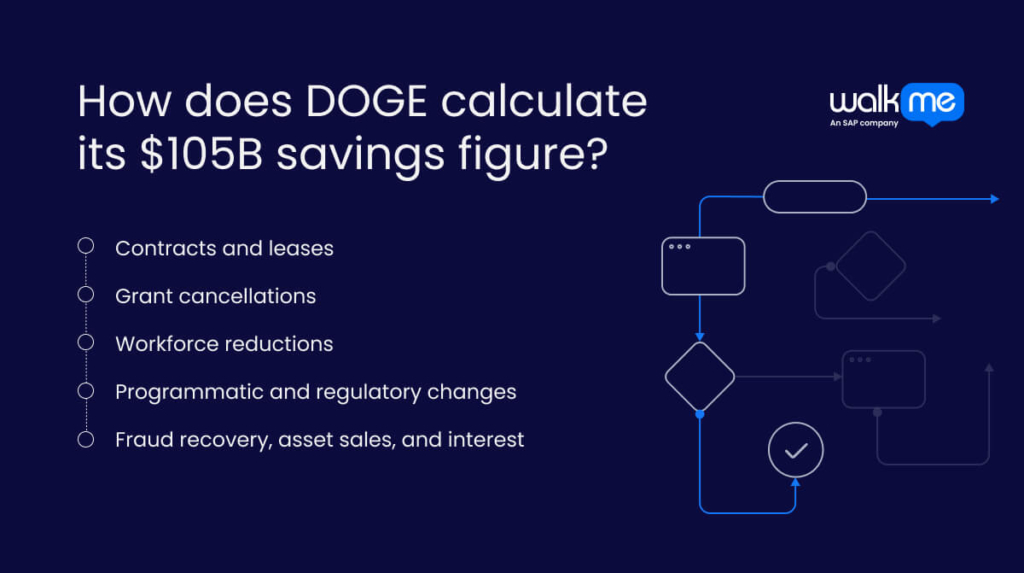The Department of Government Efficiency (DOGE) was created with a bold promise. It pledged to cut waste, streamline government digital transformation, and deliver measurable savings to taxpayers.
Behind the headlines and political fanfare lies a deeper question. What does “efficiency” look like at a national scale, and where can meaningful savings be found?
DOGE’s shifting savings projections, from trillions to billions, reveal just how complex this mission is. From procurement challenges to rolling out automation technology, cost-cutting is only part of the story.
Understanding how these savings are calculated and what they really mean requires a closer look.
This article will explore the Department of Government Efficiency’s savings, calculation methods, impacted agencies, and the broader effects of its cost-cutting measures on federal services.
What is DOGE’s claimed total savings to date?
The Department of Government Efficiency (DOGE) was established to identify and eliminate wasteful federal spending.
At the forefront of its mission is savings through tangible reductions in government expenditure achieved through cancellations, renegotiations, and reforms. These savings matter because they determine how much value taxpayers receive from a leaner public sector.
DOGE estimates $155 billion in total savings to date, spanning contracts, grants, leases, fraud elimination, and more. But transparency gaps persist. Figures posted on public sites like FPDS may lag behind internal agency reports, creating discrepancies between official sources and DOGE’s stated totals.
The table below shows a simplified overview of DOGE’s major savings areas. These figures are estimates and subject to change as reporting becomes more frequent and accurate.
| Category | Estimated savings | Description |
|---|---|---|
| Contract terminations | $28B | Cancelled or renegotiated federal contracts |
| Grant cancellations | $33B | Withdrawn or restructured grants across key agencies |
| Lease terminations | $350M | Vacated and consolidated office space |
| Fraud & improper payments | Included in $155B | Funds recovered from fraud detection and prevention |
| Workforce reductions | Included in $155B | Payroll savings from attrition and reduced hiring |
| Interest & asset sales | Included in $155B | Lower interest payments and asset offloading |
DOGE plans to improve reporting transparency and update figures weekly until real-time tracking is possible.
How does DOGE calculate its $105B savings figure?

DOGE applies tailored formulas to each category when tallying its $155 billion savings. Rather than a simple sum, DOGE uses detailed agency data to estimate the dollar impact of every cost‑cutting action.
- Contracts and leases: Savings equal the difference between each contract’s original ceiling and the amount spent, as reported in FPDS.gov termination notices.
- Grant cancellations: DOGE multiplies each cancelled grant by its average award value, based on agency funding reports.
- Workforce reductions: The number of eliminated positions is multiplied by each role’s full cost (salary plus benefits).
- Programmatic and regulatory changes: Savings come from agency budget line reviews and OIRA’s cost–benefit analyses of rule adjustments.
- Fraud recovery, asset sales, and interest: Improper payments are tallied using OMB data, while asset sales use GSA proceeds. Interest savings are derived from the difference between old and new Treasury rates.
The table below represents a snapshot of these calculation methods:
| Category | Calculation method | Estimated savings |
|---|---|---|
| Contracts & leases | Sum of (ceiling − obligated spend) across terminations | $28.35 B |
| Grant cancellations | Cancelled grants × average award value | $33.00 B |
| Workforce reductions | Eliminated positions × fully loaded employee cost | $34.65 B |
| Programmatic changes | Discontinued budgets from FY submissions | $25.00 B |
| Regulatory reforms | Net savings from OIRA cost‑benefit analyses on rule changes | $12.00 B |
| Fraud and improper payments | OMB-reported improper payment recoveries | $7.00 B |
| Asset dispositions | Proceeds from GSA surplus property sales | $2.00 B |
| Interest and debt savings | Refinanced debt × interest rate differential | $13.00 B |
| Total | $155 B |
Which major contracts has DOGE cancelled recently?

As part of its cost-saving agenda, DOGE has reviewed and cancelled several high-value contracts that no longer align with federal priorities.
Halting these agreements frees up tens of millions for more critical programs and eliminates unnecessary spending.
Let’s take a closer look:
General Micro Systems ($8 million)
For years, the US government paid General Micro Systems $8 million to maintain ageing defence computer networks. DOGE found those systems to be costly to repair and difficult to connect with newer digital tools. Cancelling the contract, DOGE freed $8 million to buy modern equipment that works across agencies. Teams must now plan for digital adoption, but this change stops spending on broken technology and helps departments share data more easily overall.
USAID–AECOM/MASS Design Group Project ($100 million)
The Department of Government Efficiency halted two AECOM contracts, totalling $100 million. It also suspended a MASS Design Group campus project in East Africa. DOGE’s review flagged overlapping goals and high costs compared to mission priorities. Pausing these agreements, DOGE aims to free funds for more urgent relief efforts, ensure tighter alignment with U.S. policy objectives, and prevent duplicate spending. While local partners must adjust plans midstream, the move underscores DOGE’s focus on making every dollar count and redirecting resources toward projects with clear, measurable impacts.
Leidos ($560,000)
Leidos held a $560,000 deal to analyse environmental data for federal parks. DOGE discovered low usage and moved the analysis in‑house. Ending the contract reclaims over half a million dollars and removes extra fees. Staff now handle data directly, which improves oversight, makes decisions more efficient, and increases their accountability. This small step highlights DOGE’s goal to reduce waste at every level and make taxpayer dollars go further.
What is the per-taxpayer savings according to DOGE?
DOGE’s per‑taxpayer savings is simply the total amount saved divided by the number of taxpayers: $155 billion ÷ 161 million equals $962.73. This average share makes large figures relatable and shows each person’s benefit.
To calculate it, DOGE sums savings from contracts, grants, leases, workforce cuts, and more, then divides by 161 million individual taxpayers.
Policymakers and citizens use this metric to judge efficiency and impact. The per‑taxpayer figure appears in DOGE’s public reports and helps justify ongoing reforms by illustrating tangible results.
It also provides a clear benchmark for future savings goals and ensures accountability within federal agencies.
Which federal agencies have been most affected by DOGE’s savings cuts?
DOGE’s savings cuts have impacted several federal agencies, driving efficiency, productivity, and efficacy, and redirecting resources to critical initiatives.
These cuts have helped streamline operations and ensure taxpayer money is used more effectively across different sectors of government.
Here’s how some of the most affected agencies have adapted:
- Centres for Medicare and Medicaid Services (CMS): DOGE cuts saved CMS by reducing unnecessary contracts and costs. This freed up money for better care and Medicaid services, making sure essential care wasn’t affected while cutting waste.
- Consumer Financial Protection Bureau (CFPB): The CFPB saved money by cutting unnecessary contracts and using in-house resources. This helped them focus on protecting consumers and enforcing financial rules without wasting money on unimportant projects.
- Department of Defence (DoD): DOGE’s cuts stopped non-critical defence contracts. The savings were used for key defence projects, ensuring military readiness and better use of taxpayer money.
- Department of Education: The Department of Education cut funding for less important programs. This saved money for essential areas, such as student loan relief and education services, ensuring that students got the support they needed.
- Federal Aviation Administration (FAA): The FAA saved by cutting outdated systems and contracts. The savings were used to upgrade air traffic control, improving safety and efficiency without wasting money on outdated equipment.
- Federal Emergency Management Agency (FEMA): FEMA saved by cutting back on nonurgent disaster projects. This allowed them to focus resources on urgent needs, improving disaster response and recovery.
- Internal Revenue Service (IRS): DOGE’s cuts helped the IRS run more efficiently. They saved money by focusing on audits and collections, reducing waste, and improving tax services.
- Medicare: Medicare saved by cutting administrative costs and improving contracts with providers. This helped them continue offering care while using money more efficiently.
- National Institutes of Health (NIH): NIH focused on important health research and cut funding for less important projects. This saved money and allowed for more progress in medical studies.
- National Oceanic and Atmospheric Administration (NOAA): NOAA saved by reducing costs on outdated technology. This helped focus on critical climate and weather studies, avoiding waste on unnecessary spending.
- Treasury Department: The Treasury saved money by cutting financial system costs. This allowed them to invest in key areas, such as economic recovery and cybersecurity.
- U.S. Agency for International Development (USAID): USAID saved by cutting redundant programs and focusing on impactful global initiatives. This made their international projects more efficient and effective.
How has DOGE’s cost-cutting affected public services?
DOGE’s cost-cutting measures aim to improve government efficiency and reduce waste.
While these changes focus on streamlining operations and saving money, they also carry potential risks that could impact essential services.
Here are some of the positive and negative outcomes these measures could bring:
Positive impacts of DOGE’s cost-cutting measures
- Streamlined government operations: One benefit of DOGE’s approach is that it could lead to a more efficient government. Cutting unnecessary programs lets the government focus its efforts on the most important services. This could help ensure that taxpayer money is being used in the best possible way, without waste or inefficiency.
- Expansion of presidential power: DOGE’s actions could strengthen the Unitary Executive theory, which advocates for more power in the hands of the president. This could lead to quicker decision-making and faster implementation of policies, as the White House would have more control over how the government functions. For some, this means more direct leadership during times of crisis.
- Reduction in government waste: Reducing spending on programs that are considered wasteful or unnecessary means DOGE can save money in the long run. For example, freezing federal grants and eliminating programs that don’t provide significant benefits could help reduce wasteful spending and make the government more accountable to taxpayers.
Negative impacts of DOGE’s cost-cutting measures
- Disruptions to critical services: One of the biggest risks of DOGE’s budget cuts is that essential services, such as Social Security and veterans’ benefits, could be delayed or disrupted. This could hurt millions of people who depend on these payments for basic living expenses. If these services face interruptions, it could create significant hardships for vulnerable citizens.
- Increased tax refund delays: Cuts to the IRS may result in delayed tax refunds, which could affect millions of Americans who rely on them for important purchases or to pay bills. Taxpayers expect these refunds on time, and delays could lead to frustration, financial strain, and even public anger.
- Risks to public health: Reducing funding for the FDA could harm its ability to track foodborne illness outbreaks. The FDA plays a key role in tracing the source of epidemics, but cuts to this service could make it harder to respond to health risks quickly. This could lead to more people getting sick, especially vulnerable groups like older people or those with weakened immune systems.
What’s next for DOGE savings?
The savings outlined in this article are still evolving, with new figures and projections emerging regularly.
As DOGE continues to implement its cost-cutting strategies, the outcomes remain uncertain. However, the overall goal is to reduce government spending, eliminate inefficiencies, and shift power toward faster decision-support systems and presidential control.
While these savings may lead to immediate fiscal benefits, the long-term impacts on government services and citizens remain to be seen.
As the situation develops, it’s essential to stay informed and adjust to any changes in programs and savings.
FAQs
DOGE is checked by audits from the Government Accountability Office (GAO) and reviews by Congress. However, because DOGE operates with some secrecy, there are concerns about how much the public and lawmakers can track what it’s doing.
Experts say DOGE’s cuts might focus too much on saving money without considering how it affects services. Some worry that reducing resources could lead to problems in important areas like healthcare and taxes, making it harder to serve the public well.
DOGE’s cost-cutting could lead to money being spent differently. Programs that are seen as less important might lose funding, while others could get more. This could change how the government spends on things like education, healthcare, and infrastructure.

